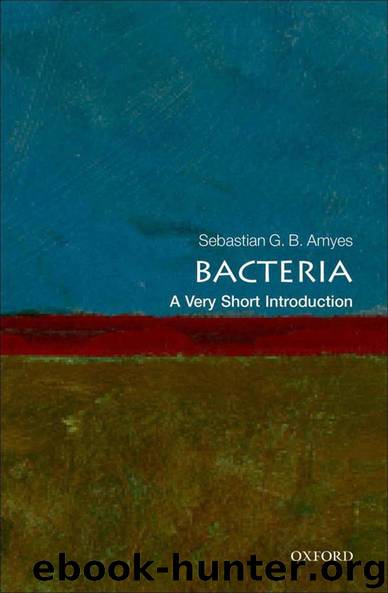Bacteria: A Very Short Introduction by Sebastian G. B. Amyes

Author:Sebastian G. B. Amyes [Amyes, Sebastian G. B.]
Language: eng
Format: epub
Tags: Science, Life Sciences, Bacteriology, General, Microbiology
ISBN: 9780199578764
Google: p5WtMaLK9-IC
Amazon: B00Y4QPW2W
Publisher: OUP Oxford
Published: 2013-05-29T22:00:00+00:00
15. Sir Alexander Fleming in his laboratory at St Mary’s Hospital, London
There are reports dating back to the 19th century where a microorganism could kill a bacterial culture, Lister had shown that Penicillium glaucum eradicated bacteria and Pasteur had demonstrated that patients treated with non-pathogenic bacteria became immune to anthrax; only Fleming realized that these microorganisms were releasing a compound that could be used as systemic therapy. He did not succeed in purifying the compound and it proved to be unstable. He published his findings in 1929 and they were then ignored for ten years.
A few years after medical qualification, Domagk started working in the pathology laboratories of I. G. Farbenindustrie (now Bayer AG) in 1927. He was interested in the bacterium Streptococcus. Domagk had been influenced by Ehrlich but thought that Ehrlich’s tests were not sufficiently rigorous. He devised an animal model in mice to examine the effects of compounds being manufactured by I. G. Farbenindustrie on animals infected with streptococci. He argued that an antibacterial compound only needed to prevent the bacteria growing and the body defences would do the rest. In 1932, Domagk tested a red dye, later called Prontosil. Mice treated with Prontosil all survived infection with Streptococcus whereas untreated mice died. Like Fleming, Domagk found that Prontosil was active against Gram-positive bacteria but not against Gram-negative; however, it was absorbed when taken orally and it was readily excreted through the kidneys, which meant that it did not accumulate.
Prontosil was tested for two years in patients with infections caused by Gram-positive bacteria, with remarkable results, curing previously fatal illnesses. In the Pasteur Institute in Paris, it was found that the active component of Prontosil was sulphanilamide, a sulphonamide. So pure sulphanilamide was used as therapy instead and a search was made for other sulphonamides which were able to inhibit bacteria that were unaffected by sulphanilamide. In particular, the search was for a sulphonamide that would cure tuberculosis. Domagk’s research slowed with the outbreak of war and, despite opposition from army surgeons, he was able to demonstrate that sulphonamides were crucial in preventing gangrene in soldiers wounded in battle.
In contrast, the war stimulated interest in antibacterials amongst the Allies. In the late 1930s, Ernst Chain was researching the use of chemicals that killed bacteria in the University of Oxford and he read Fleming’s paper on penicillin published many years earlier. A culture of Penicillium notatum had been given to the university some years before and Chain and his boss Howard Florey cultured it but also found that the penicillin produced was hard to purify. Incorrectly assuming it was an enzyme, they freeze-dried it, which not only allowed significant concentration but also stabilized it. As chemists, they were also able to remove any impurities and produced a product one million times more active than Fleming’s extract. In 1941, after extensive animal experiments, they tried the purified penicillin on a policeman dying of septicaemia caused by Staphylococcus aureus. He was treated every three hours with penicillin, his temperature dropped, and he improved until the supply of penicillin was exhausted, when he worsened and eventually died.
Download
This site does not store any files on its server. We only index and link to content provided by other sites. Please contact the content providers to delete copyright contents if any and email us, we'll remove relevant links or contents immediately.
| Administration & Medicine Economics | Allied Health Professions |
| Basic Sciences | Dentistry |
| History | Medical Informatics |
| Medicine | Nursing |
| Pharmacology | Psychology |
| Research | Veterinary Medicine |
Tuesdays with Morrie by Mitch Albom(4690)
Yoga Anatomy by Kaminoff Leslie(4306)
Science and Development of Muscle Hypertrophy by Brad Schoenfeld(4089)
Bodyweight Strength Training: 12 Weeks to Build Muscle and Burn Fat by Jay Cardiello(3913)
Introduction to Kinesiology by Shirl J. Hoffman(3725)
How Music Works by David Byrne(3187)
Sapiens and Homo Deus by Yuval Noah Harari(2987)
The Plant Paradox by Dr. Steven R. Gundry M.D(2547)
Churchill by Paul Johnson(2506)
Insomniac City by Bill Hayes(2498)
Coroner's Journal by Louis Cataldie(2432)
Hashimoto's Protocol by Izabella Wentz PharmD(2331)
The Chimp Paradox by Peters Dr Steve(2297)
The Universe Inside You by Brian Clegg(2097)
Don't Look Behind You by Lois Duncan(2080)
The Immune System Recovery Plan by Susan Blum(2027)
The Hot Zone by Richard Preston(1983)
Endure by Alex Hutchinson(1964)
Woman: An Intimate Geography by Natalie Angier(1882)
